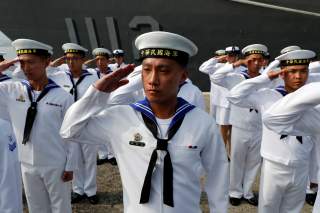Taiwanese Civilians Have an Answer to Chinese Threats: Paramilitary Groups
These are not guerillas, but first responders to a looming crisis.
TAIPEI — Taiwan citizens fed up with the military’s lack of professionalism, ineptitude and general dismissal of China’s threats to invade the island, have created a paramilitary grassroots organization to promote the revolution in military affairs.
The Taiwan Military and Police Tactical Research and Development Association (TTRDA) should not be confused with “radical” patriotic American militia, but instead with a paramilitary option to urge MND to maintain combat readiness in Taiwan.
Unprecedented in Taiwan’s post-nationalist history—these are not “guerrillas” planning to continue the fight after an invasion, but, instead, consider themselves “first responders” to a crisis.
Made up of a mix of former, reserve and active-duty special operations soldiers, current members of Taiwan’s SWAT police units, and those with special skills, the organization was created in 2015 as a non-governmental organization.
It is an invitation-only organization where members are invited based on their skill level. At present, there are about one hundred instructors with eight board members and chairman. Once a year, the board has a full member conference to report their progress over the past year, followed by elections.
Training takes place at a civilian-owned facility in Linkou, north of Taipei. Originally converted from a factory, the Military Police Command’s (MPC) Special Service Company (Nighthawks) and many tactical units began using it for close quarter combat (CQC) training because they all lacked such facilities.
In 2015, TTRDA was created and set up part of its operations there. TTRDA also set up an adjacent classroom facility for course study on everything from combat medicine to ambush tactics. The classes are available to the general public.
The owner of the factory is described as a “patriotic Taiwanese” who uses his own money to maintain the facility. There have been interactions with retired U.S. military special operations veterans who have visited the facility at TTRDA’s invitation.
The facility itself has three buildings used for CQC involving physical confrontation between combatants.
Live fire is difficult in Taiwan due to strict gun laws, but some are members of the Taiwan Shooting Sports Association-Ding Fwu and the Chinese Taipei Shooting Association.
The organization has embarrassed high-level military officers of Taiwan’s special operation forces with what has been described as better equipment and training, though active duty members of the TTRDA are enthusiastic about the training opportunity.
The organization has also become a political voice lobbying for better training in the military, which has also ruffled feathers in Army Aviation and Special Forces Command.
Though members of the various special operations units—Army Rangers, Marine Amphibious Reconnaissance Patrol, Army Frogmen (101 ARB), and Liang Shan Special Operations Company—have received some training at U.S. special operation facilities and with the former Black Water company, they often return to confront cold shoulders by army officers who see them as threats and drum many of them out of the service.
Jealousy comes at a price, as conscription for regular service is now down to four months. Active military personnel number 215,000 total, with the army making up 130,000 troops. The Reserve Command, considered the weakest of all the commands, consists of 2.5 million personnel.
Live fire is largely non-existent for those serving their four-month conscription in the army, with fewer than one hundred rounds fired during basic training using the old 5.56-millimeter T65K2 and the new 5.56 millimeter T91 assault rifle. Crews that operate the 120-millimeter T63 mortar and 66-millimeter M72 LAW anti-tank weapon are not allowed to fire live rounds, but there is extensive disassembly and cleaning. The same is true for the 40-millimeter T85 grenade launcher attached under the T91 barrel.
Conscripted soldiers are released after four months to serve in the Reserve Command, where they are required to train only five days every two years. It is unclear how many of the 2.5 million reservists actually show up for training, or how rigorous and realistic the training is, but sources indicate they are largely assigned to minor duties—painting buildings, landscaping, kitchen detail, etc.
It is also unclear why the military is reluctant to allow conscripts or reservists to train with weapons and live ammunition. There appears to be plenty of brass for everyone. The military-run 205 Arsenal manufactures a wide range of 5.56-millimeter ammunition and is now keen on selling it on the international market. The T91 has already been sold to Jordan and Indonesia and in the civilian market in the United States.
One source said that if there is one spent cartridge missing during a drill, “the whole unit will be sent out and forced to crawl all over the range just for that one goddamned casing.”
Though training is never sexy, he said, you still need different kinds of training centers to fight in different environs, whether it be cities, jungles or mountains, “but as you can see, Taiwan’s military can’t even build a proper training facility like the U.S. National Training Center.”
Wendell Minnick is an author, commentator, journalist and speaker who has spent two decades covering military and security issues in Asia, including one book on intelligence and over 1,200 articles. From 2006–2016, Minnick served as the Asia Bureau Chief for Defense News, a Washington-based defense weekly newspaper.
Image: Reuters

